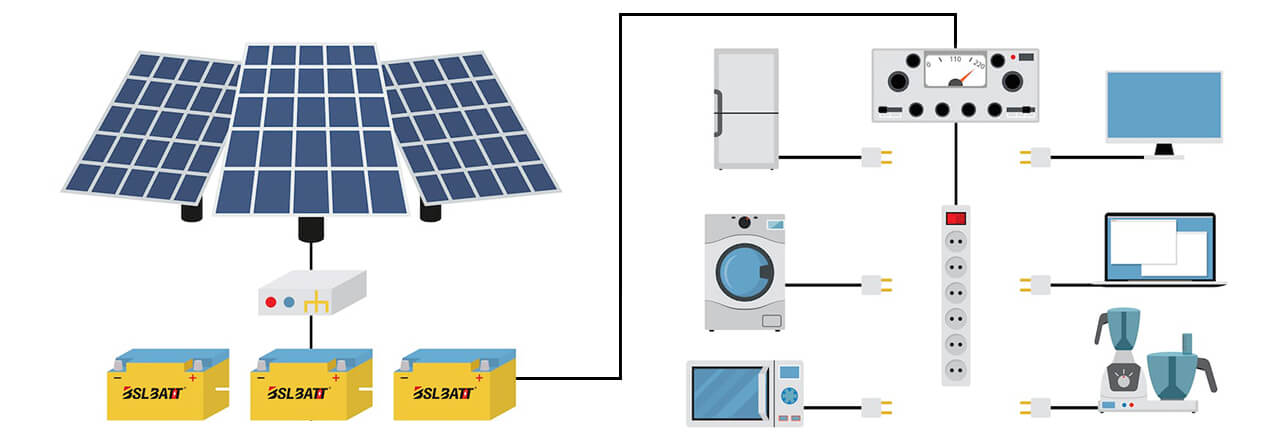Using solar panel systems at home is economical and environmentally friendly. But how to choose the right battery and inverter? In addition, calculating the size of solar panels, solar battery systems, inverters, and charge controllers is usually one of the first questions when buying a solar system. However, the correct size of the power storage device depends on many factors. In the following, BSLBATT will introduce you to the most important criteria for determining the size of solar storage systems. Oversize your solar panels, inverters, and solar power batteries and you’ll waste money. Undersize your system and you’ll compromise battery life or run out of power — particularly on cloudy days. But if you find the “Goldilocks zone” of ample battery capacity, your solar-plus-storage project will work seamlessly.
1. The Size of The Inverter
To determine the size of your inverter, the first thing to do is to calculate the maximum peak consumption. One formula to find out is to add the wattages of all the appliances in your home, from microwave ovens to computers or simple fans. The calculation result will determine the size of the inverter you use. Example: A room with two 50-watt fans and a 500-watt microwave oven. The inverter size is 50 x 2 + 500 = 600 watts
2. Daily Energy Consumption
The power consumption of appliances and equipment is generally measured in watts. To calculate the total energy consumption, multiply the watts by the hours of use.
E.g: 30W bulb is equal to 60 watt-hours in 2 hours 50W fan is turned on for 5 hours equals 250 watt-hours 20W water pump is on for 20 minutes equals 6.66 watt-hours 30W microwave oven used for 3 hours equals 90 watt-hours 300W laptop plugged into the socket for 2 hours equals 600 watt-hours Add up all the watt-hour values of each appliance in your home to know how much energy your home consumes every day. You can also use your monthly electricity bill to estimate your daily energy consumption. Besides, some of them may require more watts to start-up in the first few minutes. So we multiply the result by 1.5 to cover the working error. If you follow the example of a fan and a microwave oven: First, you can’t ignore that activation of electrical appliances also requires a certain amount of power consumption. After determining, multiply the wattage of each appliance by the number of hours of use, and then add all the subtotals. Since this calculation does not take into account the efficiency loss, multiply the result you get by 1.5. Example: The fan runs for 7 hours a day. The microwave oven runs for 1 hour a day. 100 x 5 + 500 x 1 = 1000 watt-hours. 1000 x 1.5 = 1500 watt hours  3. Autonomous Days
3. Autonomous Days
You must determine how many days you need storage battery for solar system to power you. Generally speaking, autonomy will maintain power for two to five days. Then estimate how many days there will be no sun in your area. This step is crucial to ensure that you can use solar energy throughout the year. It is better to use a larger solar battery pack in areas with more cloudy days, but a smaller solar battery pack is enough in areas where the sun is full. But, it is always recommended to increase rather than decrease the size. If the area where you live is cloudy and rainy, your battery solar system must have enough capacity to power your home appliances until the sun comes out.
4. Calculate The Charging Capacity of Storage Battery for Solar System
To know the capacity of the solar battery, we must follow the following steps: Know the ampere-hour capacity of the equipment we are going to install: Suppose we have an irrigation pump that works under the following conditions: 160mh 24 hours. Then, in this case, to calculate its capacity in ampere-hours and compare it with the lithium battery for solar system, it is necessary to apply the following formula: C = X · T. In this case, “X” equals the amperage and “T” the time on time. In the above example, the result will be equal to C = 0.16 · 24. That is C = 3.84 Ah. Compared with batteries: we will have to choose a lithium battery with a capacity greater than 3.84 Ah. It should be remembered that if the lithium battery is used in a cycle, it is not recommended to discharge the lithium battery completely (as in the case of solar panel batteries), so it is recommended not to over-discharge the lithium battery. Approximately more than 50% of its load. To do this, we must divide the number previously obtained—the ampere-hour capacity of the device—by 0.5. The battery charging capacity should be 7.68 Ah or higher. Battery banks are typically wired for either 12 volts, 24 volts or 48 volts depending on the size of the system.If the batteries are connected in series, the voltage will increase. For example, if you connect two 12V batteries in series, you will have a 24V system. To create a 48V system, you can use eight 6V batteries in series. Here are example battery banks for Lithium, based on an off-grid home using 10 kWh per day: For Lithium, 12.6 kWh is equal to: 1,050 amp hours at 12 volts 525 amp hours at 24 volts 262.5 amp hours at 48 volts
5. Determine The Size of Solar Panel
The manufacturer always specifies the maximum peak power of the solar module in the technical data (Wp = peak watts). However, this value can only be reached when the sun shines on the module at a 90° angle. Once the illumination or angle does not match, the output of the module will drop. In practice, it has been found that on an average sunny summer day, solar modules provide approximately 45% of their peak output within an 8-hour period. To reload the energy required for the calculation example into the energy storage battery, the solar module must be calculated as follows: (59 watt-hours: 8 hours): 0.45 = 16.39 watts. So, the peak power of the solar module must be 16.39 Wp or higher.
6. Determine The Charge Controller
When choosing a charge controller, the module current is the most important selection criterion. Because when the solar system battery is charged, the solar module is disconnected from the storage battery and short-circuited through the controller. This can prevent the voltage generated by the solar module from becoming too high and damaging the solar module. Therefore, the module current of the charge controller must be equal to or higher than the short-circuit current of the solar module used. If multiple solar modules are connected in parallel in a photovoltaic system, the sum of the short-circuit currents of all modules is decisive. In some cases, the charge controller also takes over consumer monitoring. If the user discharges the solar system battery too during the rainy season, the controller will disconnect the user from the storage battery in time.  Off-grid Solar System with Battery Backup Calculation Formula The average number of ampere-hours required by the solar battery storage system in a day: [(AC Average Load/ Inverter Efficiency) + DC Average Load] / System Voltage = Average Daily Ampere-hours Average Daily Ampere-hours x Days of Autonomy = Total Ampere-hours Number of batteries in parallel: Total Ampere-hours / (Discharge Limit x Selected Battery Capacity) = Batteries in parallel Number of batteries in series: System Voltage / Selected Battery Voltage = Batteries in serie In summary At BSLBATT, you can find a variety of energy storage batteries and the best solar system kits, which contain all the necessary components for your next photovoltaic installation. You will find a solar system that suits you and start using it to reduce your electricity costs. The products in our store, as well as the energy storage batteries that you can buy at very competitive prices, have been recognized by solar system users in more than 50 countries. If you need solar cells or have other questions, such as battery capacity to run the equipment you want to connect to photovoltaic installations, please feel free to contact our experts. contact us!
Off-grid Solar System with Battery Backup Calculation Formula The average number of ampere-hours required by the solar battery storage system in a day: [(AC Average Load/ Inverter Efficiency) + DC Average Load] / System Voltage = Average Daily Ampere-hours Average Daily Ampere-hours x Days of Autonomy = Total Ampere-hours Number of batteries in parallel: Total Ampere-hours / (Discharge Limit x Selected Battery Capacity) = Batteries in parallel Number of batteries in series: System Voltage / Selected Battery Voltage = Batteries in serie In summary At BSLBATT, you can find a variety of energy storage batteries and the best solar system kits, which contain all the necessary components for your next photovoltaic installation. You will find a solar system that suits you and start using it to reduce your electricity costs. The products in our store, as well as the energy storage batteries that you can buy at very competitive prices, have been recognized by solar system users in more than 50 countries. If you need solar cells or have other questions, such as battery capacity to run the equipment you want to connect to photovoltaic installations, please feel free to contact our experts. contact us!
Post time: May-08-2024








